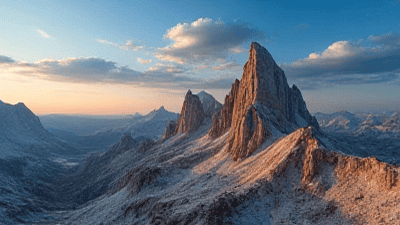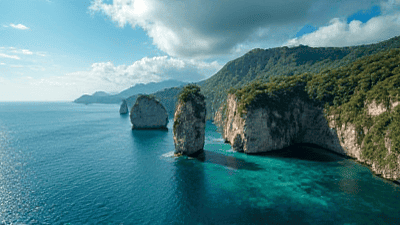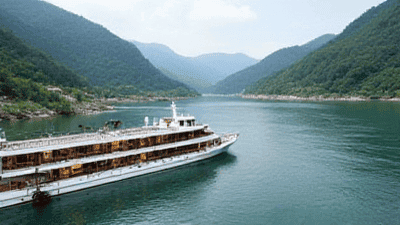
The world is a breathtaking tapestry of natural beauty, with landscapes that leave us in awe and inspire a sense of wonder. From towering mountains to sparkling oceans, lush forests to expansive deserts, nature offers a plethora of stunning wonders that showcase the earth's beauty and diversity.
The Importance of Natural Wonders
Natural wonders represent more than just beautiful sights; they are ecosystems that support diverse wildlife, historical landmarks that tell the story of our planet, and locations that inspire conservation efforts. Traveling to these wonders allows us to connect with nature, appreciate its beauty, and understand the importance of protecting our environment. Here, we spotlight some of the most stunning natural wonders that should be on every traveler's bucket list.
1. The Grand Canyon, USA
The Grand Canyon, located in Arizona, is one of the most recognizable natural wonders in the world. Its immense size, complex geological structures, and colorful layers of rock create a mesmerizing landscape. Spanning 277 miles in length and up to 18 miles wide, the canyon was carved by the Colorado River over millions of years. Visitors can explore the rim via various hiking trails, take guided tours, or even embark on a rafting adventure down the river. The stunning sunrises and sunsets cast vibrant hues over the canyon, making it a photographer's paradise.
2. The Great Barrier Reef, Australia
The Great Barrier Reef is the largest coral reef system on the planet, stretching over 1,400 miles along the coast of Queensland. It is home to more than 1,500 species of fish, 400 types of coral, and countless marine creatures, making it one of the most biodiverse ecosystems on Earth. Snorkeling and scuba diving in the crystal-clear waters provide an incredible opportunity to witness the vibrancy of coral and marine life up close. Conservation efforts are critical in preserving the reef, which faces challenges from climate change and pollution, making responsible tourism essential.
3. Victoria Falls, Zambia/Zimbabwe
Victoria Falls, located on the border of Zambia and Zimbabwe, is considered one of the largest and most spectacular waterfalls in the world. Known as "Mosi-oa-Tunya," or "the smoke that thunders," it is nearly a mile wide and drops over 354 feet into the Zambezi River below. The sheer power and beauty of the falls create a mesmerizing mist that fills the surrounding air. Visitors can view the falls from various vantage points and even take part in thrilling activities like bungee jumping, white-water rafting, and helicopter tours for a bird's-eye perspective.
4. Aurora Borealis, Arctic Region
The Northern Lights, or Aurora Borealis, are a natural light display that occurs in the Arctic regions, primarily in countries like Norway, Sweden, Canada, and Finland. This stunning phenomenon is caused by solar particles colliding with the Earth’s atmosphere, creating colorful waves of green, purple, and pink lights dancing across the night sky. The best time to witness the Aurora Borealis is during the winter months when clear skies prevail. Traveling to remote locations increases the chances of experiencing this breathtaking spectacle, making it a must-see for any traveler.

5. The Amazon Rainforest, South America
The Amazon Rainforest, often referred to as the "lungs of the Earth," spans over five countries: Brazil, Peru, Colombia, Venezuela, and Ecuador. It is the largest tropical rainforest and houses an incredible diversity of flora and fauna, including thousands of plant species, birds, mammals, and reptiles. Exploring the Amazon is an adventure of a lifetime, with opportunities for guided wildlife tours, canopy walks, and cultural exchanges with indigenous tribes. This unique ecosystem is vital to our planet's health, and eco-tourism in the Amazon promotes sustainability and conservation efforts.
6. Mount Everest, Nepal/Tibet
Mount Everest, the highest peak in the world, stands at 29,032 feet above sea level and is a dream destination for many adventure seekers. Located in the Himalayas on the border between Nepal and Tibet, Everest attracts climbers from around the globe. The journey to the summit is challenging and requires careful planning, training, and respect for the mountain's dangers, such as altitude sickness and harsh weather conditions. For those who prefer a less strenuous experience, the trails to base camp offer stunning views of the mountain and surrounding landscapes, allowing trekkers to appreciate the grandeur of the Himalayas.
7. The Northern Patagonian Ice Field, Chile/Argentina
The Northern Patagonian Ice Field, located in the Andes mountains of Chile and Argentina, is a stunning expanse of ice that feeds dozens of glaciers. The region is a UNESCO World Heritage site and offers dramatic landscapes of towering mountains, glaciers, and turquoise lakes. Visitors can explore the ice field on guided treks or glacier tours, taking in the surreal beauty of the frozen environment. The nearby town of El Chaltén offers a range of hiking opportunities, including trails to the famous Fitz Roy massif, known for its rugged peaks and breathtaking scenery.
8. The Sahara Desert, Africa
The Sahara Desert is the largest hot desert in the world, covering large parts of North Africa. This vast, arid expanse is known for its stunning sand dunes, rocky plateaus, and unique ecosystems. Exploring the Sahara offers a chance to witness awe-inspiring landscapes, colorful sunsets over the sand dunes, and ancient oases. Camel trekking is a popular way to experience the desert, allowing travelers to connect with the landscape while gaining insights into the culture and traditions of the Berber and Tuareg people who inhabit the region.
9. The Galápagos Islands, Ecuador
The Galápagos Islands are a UNESCO World Heritage site renowned for their exceptional biodiversity and unique wildlife. This archipelago, located off the coast of Ecuador, inspired Charles Darwin’s theory of evolution due to its distinctive species, such as giant tortoises, marine iguanas, and blue-footed boobies. The islands offer countless opportunities for exploration, from snorkeling with sea lions to hiking volcanic landscapes. As a protected national park, responsible tourism practices are essential to preserving the fragile ecosystems of the Galápagos.
10. Yellowstone National Park, USA
Yellowstone National Park, the first national park in the world, is famous for its geothermal features, including the iconic Old Faithful geyser and vibrant hot springs. Spanning over 3,400 square miles in Wyoming, Idaho, and Montana, Yellowstone is home to an array of wildlife, such as bison, elk, and grizzly bears. Visitors can explore the park through miles of hiking trails, scenic drives, and guided tours. The stunning landscapes, diverse ecosystems, and rich history make Yellowstone a true natural wonder.
Tips for Visiting Natural Wonders
1. Respect the Environment
When visiting natural wonders, it is essential to practice responsible tourism. Follow designated trails, avoid littering, and respect wildlife habitats. Leaving no trace helps preserve these stunning locations for future generations.
2. Plan Ahead
Many natural wonders require advance planning, especially for activities like hiking, camping, or guided tours. Research the best times to visit, necessary permits, and any safety recommendations.
3. Pack Accordingly
Be prepared for varying weather conditions, especially in remote or high-altitude areas. Appropriate clothing, footwear, and essential gear (like water, snacks, and a first-aid kit) can significantly enhance your experience.
4. Engage with Local Communities
Many natural wonders are surrounded by local communities that rely on responsible tourism for their livelihoods. Engage with residents, support local businesses, and learn about their culture and stories.
5. Capture Memories Respectfully
Photography is a fantastic way to remember your travels but be mindful of your surroundings and the people in them. Always ask for permission before photographing individuals, and avoid disturbing wildlife while trying to get the perfect shot.
Conclusion
The world is filled with stunning natural wonders that captivate our senses and inspire a sense of adventure. From the majestic heights of Mount Everest to the mesmerizing depths of the Amazon Rainforest, these breathtaking sites offer experiences that connect us with the beauty and diversity of our planet. By exploring these wonders, we not only create unforgettable memories but also foster a deeper appreciation for nature and the importance of conservation. So, pack your bags and get ready to embark on a journey to discover the world's most stunning natural wonders.


